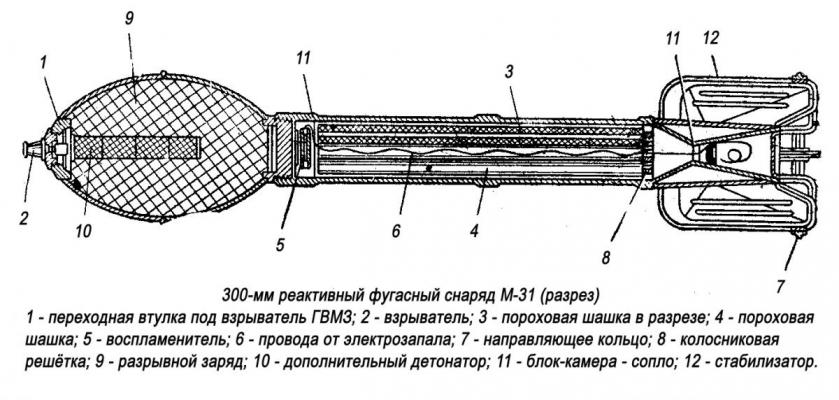Designed to destroy fortified points and resistance units of the enemy, engineering structures and obstacles. M-31 projectile consisted of two main parts: the head and the missile.
The head part consisted of the head housing and explosive charge 9, ammatol or TNT.
The body of the head consisted of two welded halves of ogival shape. There was a hole in the frontal part of the head body through which the explosive charge was carried out. After the equipment, a bushing 1 was screwed into this hole with a point for a GVMZ fuse. At the rear of the head housing there was a welded bottom with threads for screwing into the rocket chamber.
The missile part consisted of the rocket chamber block with nozzle 11 and stabilizer 12.
In the rocket chamber was placed a charge of nitroglycerine powder, consisting of five single-channel cylindrical draughts 3, which are separated from the nozzle part of the grate 8. The outer diameter of a draughts is 46 mm, the diameter of the channel is 8 mm, the length of a draughts is 900 mm.
To ignite the powder charge in the rocket chamber was located igniter 5 of smoke gun powder weighing 75 g. The igniter is inserted into the plywood diaphragm. The ignition of the ignition was from an electric ignition chamber sewn into the ignition cartridge. The wires 6 of the igniter passed along the entire length of the rocket chamber; their ends were placed in the outlet cone of the nozzle between two cardboard plates.
To make the M-31 projectile stable in the flight was a stabilizer, consisting of a fairing, eight wings and a guide ring 7. The ring was used to guide the tail part of the projectile as it moved along the guide cells.
Also see the schematic of the M-31 projectile from the Service Manual for the BM-31-12 combat vehicle, issued in 1955 (diagram).
Based on the M-31, the M-31-UK projectile was developed.
| Caliber, mm | 300 | |
| Stabilizer wingspan, mm | 300 | |
| Full projectile length (without fuse), mm | 1760 | |
| Weight of final projectile, kg | 94,8 | |
| Header type | blast | |
| Weight of rigged head end, kg | 52,4 | |
| Weight of explosive charge, kg | 28,9 | |
| Weight of the rocket part, kg | 42 | |
| Powder charge weight, kg | 11,25 | |
| Fuse | GVMZ | |
| Resistance of incandescent bridge of electric ignition, Ohm | 1,0-1,4 | |
| The current needed to ignite the igniter, A. | not less than 0.5 | |
| Balistic data | ||
| Rocket charge burning time, s | 0,9 | |
| Average reactive force, kg | 2500 | |
| Muzzle velocity of the projectile, m/s | 35 | |
| The length of the active section of the trajectory, m | 115 | |
| Highest projectile speed, m/s. | 245 | |
| The longest range of fire, m. | 4000 | |
